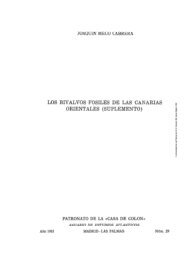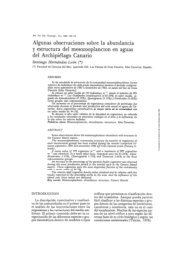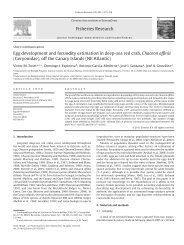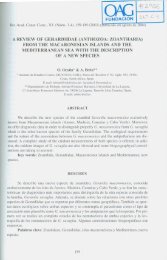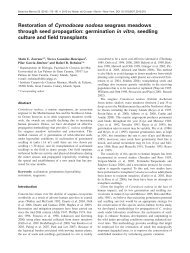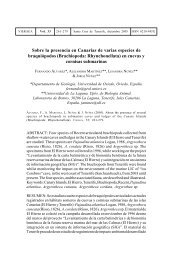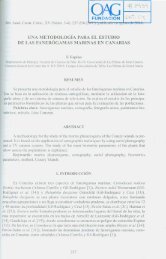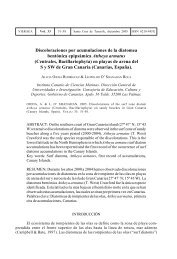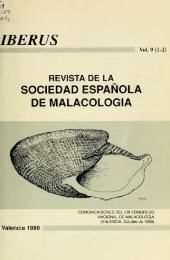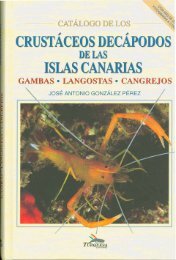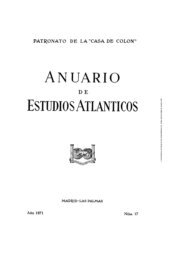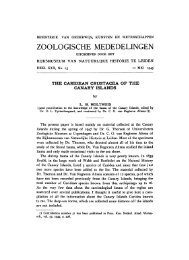of the madeira and selvagens archipelagos - redmic
of the madeira and selvagens archipelagos - redmic
of the madeira and selvagens archipelagos - redmic
You also want an ePaper? Increase the reach of your titles
YUMPU automatically turns print PDFs into web optimized ePapers that Google loves.
Resumo<br />
1. A fauna de vertebrados (Chordata) em ecossistemas insulares<br />
é normalmente composta por um pequeno número<br />
de taxa, com uma proporção considerável de endemismos.<br />
Este padrão geral também se observa nos<br />
arquipélagos da Madeira e Selvagens.<br />
2. Nestas ilhas ocorrem apenas quatro classes de vertebrados<br />
terrestres nativos: Actinopterygii (peixes de água<br />
doce), Reptilia (répteis), Aves (aves) e Mammalia (mamíferos).<br />
3. Os vertebrados introduzidos pertencem às classes Amphibia<br />
(anfíbios) e Mammalia.<br />
4. Com base num estudo detalhado dos registos de ocorrência<br />
de espécies provenientes de publicações e de outros<br />
trabalhos adicionais não publicados, estão presentes<br />
na Madeira e Selvagens 61 espécies e subespécies<br />
de vertebrados terrestres: três Actinopterygii, um Amphibia<br />
(rã), sete Reptilia (lagartixas ou osgas), 38 Aves e 12<br />
Mammalia.<br />
5. No total, 12 espécies e subespécies são endémicas da<br />
Madeira e Selvagens (19,7%), 10 são endémicas da Macaronésia<br />
(16,4%), 26 são nativas (42,6 %) e 13 são introduzidas<br />
(21,3%).<br />
6. Uma análise dos padrões biogeográficos das espécies<br />
de vertebrados na Madeira e Selvagens mostra que o<br />
grupo mais diverso de vertebrados em número de espécies,<br />
as aves, apresenta a desarmonia taxonómica típica<br />
de ecossistemas insulares.<br />
7. As aves e os répteis totalizam 92% de todas as espécies<br />
e subespécies endémicas presentes nestas ilhas.<br />
A maior proporção de taxa endémicos ocorre nas ilhas<br />
da Madeira e Porto Santo, de maiores dimensões e com<br />
topografias mais complexas.<br />
CAPÍTULO 11 | CHAPTER 11<br />
OS VERTEBRADOS (CHORDATA) DOS ARQUIPÉLAGOS<br />
DA MADEIRA E DAS SELVAGENS<br />
THE VERTEBRATES (CHORDATA)<br />
OF THE MADEIRA AND SELVAGENS ARCHIPELAGOS<br />
Paulo Oliveira<br />
Serviço do Parque Natural da Madeira, Quinta do Bom Sucesso, Caminho do Meio, 9050–251 Funchal, Madeira, Portugal; e -mail:<br />
paulooliveira.sra@gov -<strong>madeira</strong>.pt<br />
357<br />
Abstract<br />
1. The vertebrate Fauna <strong>of</strong> isl<strong>and</strong>s is normally composed <strong>of</strong><br />
a small number <strong>of</strong> taxa, with a considerable number <strong>of</strong><br />
endemics. The Madeira <strong>and</strong> Selvagens <strong>archipelagos</strong> are<br />
no exception to this general rule.<br />
2. In <strong>the</strong> Madeira <strong>and</strong> Selvagens <strong>archipelagos</strong> only four<br />
classes <strong>of</strong> native vertebrates can be found: freshwater<br />
fishes (Actinopterygii), lizards (Reptilia), birds (Aves) <strong>and</strong><br />
mammals (Mammalia).<br />
3. The introduced vertebrates are amphibians (Amphibia)<br />
<strong>and</strong> mammals.<br />
4. Based on a detailed survey <strong>of</strong> <strong>the</strong> published literature<br />
<strong>and</strong> additional unpublished records, we counted 61<br />
species <strong>and</strong> subspecies, <strong>of</strong> which three are freshwater<br />
fishes, one is a frog, seven are lizards or geckos, 38 are<br />
birds <strong>and</strong> 12 are mammals.<br />
5. It was also found that 12 species or subspecies are endemic<br />
to <strong>the</strong> Madeira <strong>and</strong>/or Selvagens <strong>archipelagos</strong><br />
(19.7%), 10 are endemic to Macaronesia (16.4%), 26 are<br />
indigenous (42.6 %) <strong>and</strong> 13 are introduced (21.3%).<br />
6. A brief analysis <strong>of</strong> <strong>the</strong> biogeographical patterns showed<br />
that <strong>the</strong> most diverse vertebrate group, <strong>the</strong> birds, presents<br />
<strong>the</strong> characteristic taxonomic disharmony <strong>of</strong> isl<strong>and</strong>s.<br />
7. The analysis <strong>of</strong> evolutionary patterns showed that birds<br />
<strong>and</strong> lizards account for 92% <strong>of</strong> all <strong>the</strong> endemic species<br />
<strong>and</strong> subspecies <strong>of</strong> <strong>the</strong>se isl<strong>and</strong>s. This analysis also revealed<br />
that <strong>the</strong> highest proportion <strong>of</strong> endemic species <strong>and</strong><br />
subspecies is found on <strong>the</strong> bigger <strong>and</strong> topographically<br />
more complex isl<strong>and</strong>s <strong>of</strong> Madeira <strong>and</strong> Porto Santo.<br />
8. The analysis <strong>of</strong> <strong>the</strong> conservation status <strong>of</strong> <strong>the</strong> vertebrates<br />
<strong>of</strong> <strong>the</strong> Madeira <strong>and</strong> Selvagens <strong>archipelagos</strong> <strong>and</strong> <strong>the</strong>ir<br />
habitats gave us <strong>the</strong> impression that <strong>the</strong> implemented<br />
management model is reasonably effective.



